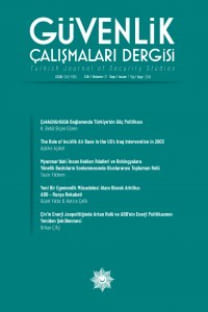Peru’nun ‘Aydınlık Yol’ Örgütü: Latin Amerika Üniversite Radikalliğinin Bir Ürünü Mü?
Bu makale Latin America’da üniversite radikalleşmesine dair bir perspektif sunmakta ve Peru’da aşırı-sol Maocu bir gerilla örgütünün ortaya çıkışını tartışmaktadır. Günümüzde Ortadoğu’yu içine alan radikalleşme süreçleriyle karşılaştırıldığında, Peru tecrübesi, özellikle tarihsel, kültürel ve siyasal gerçeklikler göz önüne alındığında alakasız durabilir. Gerçekten de dünyanın bir köşesindeki olaya dair detaylar dünyanın geri kalanında farklı tarihsel ve siyasal tecrübelere ve durumlara denk düşmeyebilir. Ancak Latin Amerika tarihinin en ideolojik temeli aşırılıkçı terör örgütünün yükselişi ve düşüşünün ele alındığı bu makale bu tür akımların neden başarılı olduğu ve nasıl düşüşe geçtiğine dair kıymetli ipuçları sunabilir. Aydınlık Yol örgütü gibi tek bir profesörün liderliğinde, üniversite ortamında, on yıldan fazla bir sürede ortaya çıkan radikal bir örgüt öğrenim ve ulusal kalkınma için tasarlanmış, varlık amaçları bunlar olan bir kurumsal ortamın üniversitenin nasıl manüpüle ve istismar edilebileceğine dair ders niteliğinde bilgiler sunmaktadır
Anahtar Kelimeler:
Aydınlık Yol, Radikalleşme, Abimael Guzmán, Peru
SHINING PATH OF PERU: A PRODUCT OF LATIN AMERICAN UNIVERSITY RADICALISM?
This paper provides a perspective on university radicalization in Latin America and the emergence of a far-left Maoist guerrilla organization in Peru. In comparison with the radicalization process which has inflamed much of the Middle East in recent years, Peru’s experience may not appear to be particularly relevant, given such differences in historical, cultural, and political realities. It is clearly the case that lessons learned from experiences in one part of the world do not necessarily translate well into other historical, cultural, religious, and political contexts. In fact, however, this case study of the rise and fall of the most extreme ideologically-driven terrorist organization in Latin American history provides a significant number of insights into why such movements succeed – and why they fail. The ability of a radical organization like Shining Path to emerge in a university under the leadership of a single professor over well more than a decade should offer an object lesson in how an institutional context specifically designed for learning and contributing to national progress can be grossly manipulated and abused
Keywords:
Shining Path, University, Radicalization, Abimael Guzmán,
___
- BALAN, Jorge (2013). “Latin American Higher Educational Systems in a Historical and Comparative Perspective,” in Latin America’s New Knowledge Economy (New York: International Instituute of Education), i-xiv
- DEGREGORI, Carlos Iván (1990). Ayacucho 1969-1979: El surgimiento de Sendero Luminoso (Lima: Instituto de Estudios Peruanos)
- __________ (1994). “The Origins and Logic of Shining Path: Return to the Past,” in David Scott Palmer, ed. Shining Path of Peru, 2nd edition, 33-44
- GORRITI Ellenbogen, Gustavo (1990). Sendero. La historia de la Guerra milenaria en el Perú (Lima: Editorial Apoyo)
- __________ (1994). “Shining Path’s Stalin and Trotsky,” in David Scott Palmer, Ed. Shining Path of Peru, 2nd edition, 149-170
- GUZMÁN Reynoso, Abimael (1993). English translation and transcription of his interview in prison after his capture, Foreign Broadcast Information Service (FBIS), U.S. Government
- HERRING, Hubert (1955). A History of Latin America (New York: Knopf)
- HUDSON, Rex A. (1988). Castro’s Americas Department Coordinating Cuba’s Suppport for Marxist-Leninist Violence in the Americas (Miami: Cuban American National Foundation)
- KLARÉN, Peter F. (2000). Peru: Society and Nationhood in the Andes (New York: Oxford University Press)
- LEVY, Daniel C. (1986). Higher Education and the State in Latin America (Chicago: University of Chicago Press)
- MORALES Domínguez, Esteban & Gary Prevost (2008) U.S.-Cuban Relations: A Critical History (Lanham MD: Lexington Books)
- PALMER, David Scott (1966). “Expulsion from a Peruvian University,” in Robert B. Textor, ed. Cultural Frontiers of the Peace Corps (Cambridge: M.I.T. Press), 243-270
- __________ (1986). “Rebellion in Rural Peru: The Origins and Evolution of Sendero Luminoso,” Comparative Politics 18:2 (January), 127-146
- _________ (2001). “FONCODES y su impacto en la pacificación en el Perú: Observaciones generaales y el caso de Ayacucho,” Concertando para el desarrollo: Lecciones aprendidas del FONCODES en sus estrategias de intervención (Lima: Gráfica Medelius), 147-175
- __________(2015). “Countering Terrorism in Latin America: The Case of Shining Path in Peru,” in James J.F. Forest, ed. Essentials of Counterterrorism (Denver: Praeger), 251-270)
- ROCK, David (1977). El radicalismo argentino 1890-1930 (Buenos Aires: Editorial Amorrotu)
- ROMERO Pintado, Fernando (1961). “New Design for an Old University: San Cristóbal de Huamanga,” Américas (December), 9-16
- WIARDA, Howard J. and Harvey F. Kline (1990). Latin American Politics and Development. 3rd Edition (Boulder: Westview Press)
- ISSN: 2148-6166
- Başlangıç: 2000
- Yayıncı: Polis Akademisi Başkanlığı
Sayıdaki Diğer Makaleler
Bir Aşırı Sağ Örgütün Yapısı: Soldiers Of Odin
Sosyal Ve Beşeri Bilimlerden Radikal Örgütlere: Türkiye’de Radikalleşme, Terör Ve Üniversite
Ortadoğu ve Kuzey Afrika’da Üniversiteler ve Radikalleşme
Peru’nun ‘Aydınlık Yol’ Örgütü: Latin Amerika Üniversite Radikalliğinin Bir Ürünü Mü?
Arap Üniversite Öğrencileri Arasında Radikalleşmeye Yol Açan Faktörler
